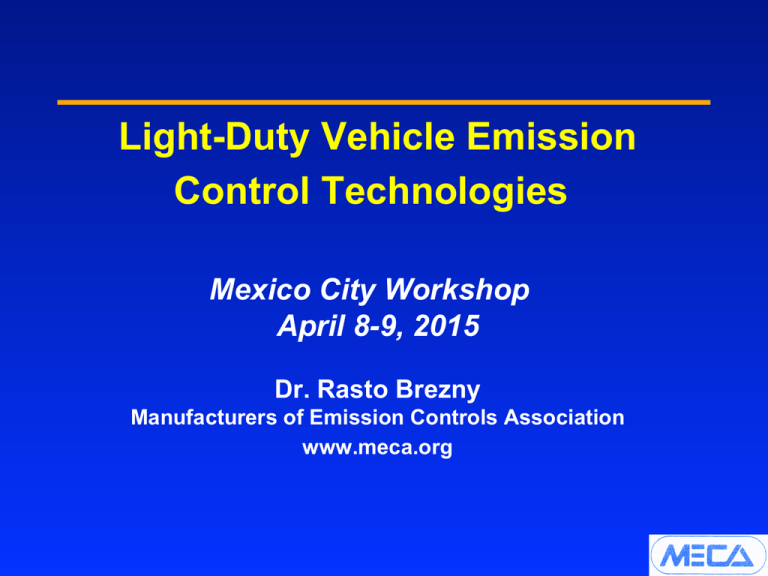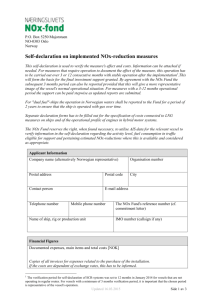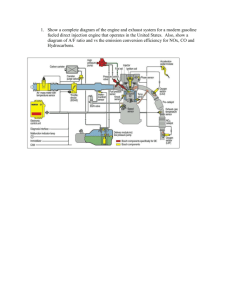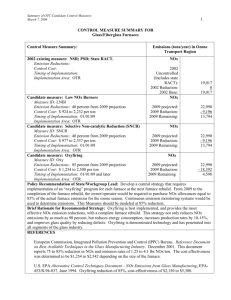Light-Duty Vehicle Emission Control Technologies
advertisement

Light-Duty Vehicle Emission Control Technologies Mexico City Workshop April 8-9, 2015 Dr. Rasto Brezny Manufacturers of Emission Controls Association www.meca.org Light-duty Vehicle Emission Control Technologies Outline • Gasoline Vehicle Technologies for Tier 2/Tier 3 & LEV II/LEV III • Light-duty Diesel Emission Control Technologies MECA - Industry Technology Voice with North American Regulatory Agencies and Stakeholders; 38 Member Companies Cover Major OEM & Aftermarket Emission Control Suppliers OEM OEM Sourcing Decisions Made by the OEM SUBSTRATES & MATS CATALYSTS Manufacturing Flow Emission Control Industry supports > 65,000 jobs in the U.S.; manufacturing facilities also in Mexico EXHAUST SYSTEMS (sensors, canning, air pumps, urea delivery) EVAP. SYSTEMS (carbon canisters; purge valves; low permeation materials) Mobile Source Emissions Regulations Drive Technology Innovation • Light-duty: U.S. Tier 2/LEV II moving to Tier 3/LEV III – Near Zero gasoline exhaust emissions: advanced TWCs, HC adsorber cats, high cell density substrates, direct ozone reduction catalysts – Near Zero gasoline evap. emissions: advanced carbon canisters, low permeation materials, air intake adsorbents – Near Zero diesel exhaust emissions: EGR, DPFs, LNT, SCR • U.S. 2007-2010 Heavy-Duty Highway Diesel – DOC, DPFs, SCR, EGR • U.S. Tier 4 Off-Road Diesel – DOC, DPFs, SCR, EGR The Three-way Catalytic Converter: A Familiar Technology Re-Engineered for High Performance • Provides high efficiency “three-way (HC, CO, NOx)” performance • High cell density ceramic or metallic substrates • Advanced materials with high thermal stability • Layered catalytic architectures to maximize noble metal (Pt, Pd, Rh) effectiveness LEV III/Tier 3 Applications Continue to Emphasize Cold-Start & High Speed NOx Performance Thermal Management Focused on Cold-Start Emission Reductions High Cell Density, Thin Wall Substrates Air Gap Insulation Tightening Regulations Require Higher Substrate Cell Density/ Geometric Surface Area; Emerging Markets Moving from Standard Wall to Thin Wall and Ultra-thin Wall Substrates Substrates Used on Gasoline Light-duty Vehicles 2013 (estimate) 2020 (forecast) cells/in2 By 2020 400 cpsi substrates primarily used only in underfloor converters that utilize high cell density (≥ 600 cpsi) close-coupled converters cells/in2 Gasoline Three-way Catalysts Utilize Advanced Design Architectures to Maximize Performance Pd is zoned in the front to give fast HC light-off Rh is zoned in the back to protect against catalyst poisons Toyota, SAE 2011-01-0296 Zoned OSC to give optimum performance SAE 2014-01-1508 PZEV Experience with Turbo-GDI Applications Secondary Air Injection ULEV2 600 cpsi 2.3 liter 60 g/ft3 PZEV 900 cpsi 2.5 liter 150 g/ft3 ULEV2 PZEV 40 g/ft3 100 g/ft3 ULEV2 TWC Upgrade Lean Stratified Secondary Fast TWC Premair Air Heat-up Credit Start Source: 2007 Aachen Colloquium Variety of PZEV Strategies in the U.S. Market Vehicle Engine Displacement PFI or DI NA or Turbo AIR or non-­‐AIR Average Ignition Setting (obtc) Engine Speed (rpm) Lambda Max Cat Temp (oC) Vehicle A B C D E A 2.0 DI Turbo AIR B 2.4 PFI NA AIR C 2.0 PFI NA non-­‐AIR D 2.4 DI NA non-­‐AIR E 2.4 PFI NA AIR -­‐20 1150 1.05 (AIR) 670 0 1200 >>1 (AIR) 1000 -­‐7 1500-­‐1700 .95-­‐1 500 -­‐12 1200-­‐1500 .95-­‐1 700 -­‐5 900-­‐1200 >>1 (AIR) 950 Positives PZEV turbo, low startup engine speed, more accurate fuel control Extremely fast catalyst light-­‐off, low startup engine speed, less calibration time Lowest system cost Split injections enable fast lightoff w/o AIR Extremely fast catalyst light-­‐off, low startup engine speed, less calibration time Ref. : SAE 2012-01-1245 Negatives High system cost/complexity Cost of AIR, excess fuel used in start-­‐up High engine speed in first idle Additional calibration effort Cost of AIR, excess fuel used in start-­‐up 2011 5.3 L Chevy Silverado Full Size Pick-up: 150K mi Aged Advanced TWC System Tier 3 Bin 30 FTP Emissions with 9 ppm S E10: 18 mg/mi NMOG+NOx with 29 ppm S E10: 29 mg/mi NMOG+NOx CC 5.3L V8 with cyl. deactivation Engine 900 cpsi /2.5 mil wall ceramic; Pd/Rh UF Pd/Rh CC TWC System Bench Aged to 150K miles; Total TWC Catalyst Volume: 1.90 L (0.36 SVR) Pd/Rh = 16/1; 125 g/cu.ft. (8.4 g PGM total) Gasoline Sulfur Degrades Catalyst Performance: Example Chevy Malibu PZEV Application 2.4 liter, 4 cyl.: CC+UF TWCs Ref.: SAE 2011-01-0300 UF never above UF at 700-750 C NO NOx “creep” 600 C with FTP; during US06; with 3 ppm S NOx “creep” NO NOx “creep” Additional Cold-Start HC Control Available From Hydrocarbon Traps • Limited SULEV/PZEV HC trap applications to date • Development work continuing with focus on durability/cost • Example: HC trap PGM loading of only 26 g/ft3 Reference: SAE 2013-01-1297 U.S. Evaporative Emission Standards Provide Comprehensive VOC Controls for Gasoline Vehicles Standard US ≤ 1995 and Euro Evap. Stds. ORVR 24-hr Diurnal US ≥ 1996-2004 ü ü 48-hr Diurnal ü 72-hr Diurnal ü Evap Standard = 2 g/day ü Evap Standard < 0.5-1.2 g/day Hot Soak ü ü ü Running Loss ü In-use standards and monitoring ü OBD ü Since 1996, the US progressively added ORVR, extended diurnals, short drive cycles, running loss, low certification and in-use emissions standards, and OBD to improve air quality. CANISTER EMISSIONS Carbon Technologies to Achieve PZEV/LEV III Evaporative Requirements Addition of Canister Scrubbers Low Purge Low Purge • Honeycombs Without Scrubber Normal Purge • Low Bleed Carbon With Scrubber Normal Purge Reduction of 95-295 mg/test 0 100 200 300 0 400 100 150 200 250 300 Average Emissions (mg/test) Average Emissions (mg/test) AIS EMISSIONS 50 Addition of AIS Traps 8-Cylinder Without Trap 4-Cylinder 8Cylinder • Honeycombs • Carbon Sheet • Low dP Elements • Carbon Cylinders 4Cylinder With Trap Reduction of 100-200 mg/test 0 50 100 150 200 250 300 Average Emissions (mg/test) 0 50 100 150 200 250 300 Average Emissions (mg/test) Combustion Efficiency Technologies and Gasoline Particulate Filters GHG Compliance Creates Emission Control Opportunities GDI PM/PN: Filter opportunities? Smaller cats; Cooler exhaust; Opportunities for thermal management, HC adsorbers Engine Downsizing Driving Turbo Advances Turbo compounding Stamped turbo housing Regulated 2-Stage Regulated 3-Turbocharger System Electric turbocharging Water-cooled Turbocharger Lower Engine Out Emissions must Include GHGs Decoupling the CO2 – NOx Relationship • Low and high pressure EGR LP EGR Valve HP EGR Valve EGR Cooler Piezo Injectors Thermoelectric Generators Exhaust Heat Recuperators Corona Ignition GPF Vehicle Durability Run Completed 2.0 L Audi TFSI CC TWC (stock) + UF TWC GPF Stock Catalyst CC: TWC 1.24L 80g/ft³ > 2X EU6 PN limit CAPoC9, August 2012 21 Test Converter Layout CC TWC + UF converter CC: TWC 1.24L UF: GPF 1.68L 64g/ft³ 10g/ft³ Gasoline Particulate Filters Commercialized in Europe • Mercedes S500 is first GPF introduction • Durability has been demonstrated • Benefits in off-cycle driving RTS 95 Aggressive Euro 6c Limit No GPF 22 2014 Aachen Colloquium Aged GPF Light-duty Diesel Emisson Control Technologies First Wave LEV II/Tier 2 Light-Duty Clean Diesels FTP Emissions: 30 to 50 mg/mi NOx; 12 to 23 mg/mi NMHC FTP-75 NMOG and NMHC at Full Usefull Life FTP-75 NOx at Full Usefull Life 0.1 0.08 Bin 5 / LEV / ULEV T2B5/LEV 0.09 0.07 0.08 NMOG, NMHC (g/mile) NOx (g/mile) 0.06 0.05 0.04 Bin 2 0.03 0.02 0.07 0.06 ULEV 0.05 0.04 0.03 Bin 2 0.02 0.01 0.01 0 0 Mercedes ML Mercedes GL 320 Blutec 320 Blutec BMW 335d DPF+SCR BMW X5 VW Jetta (Bin 5) VW Jetta (Calif. ULEV) Mercedes ML Mercedes GL BMW 335d 320 Blutec 320 Blutec DPF+LNT DPF+SCR BMW X5 VW Jetta (Bin 5) DPF+LNT Current best in class: 50 mg/mi NMHC+NOx (compare to 30 mg/mi NMHC+NOx for Bin 2 or SULEV) CARB certification data VW Jetta (Calif. ULEV) Diesel Particulate Filters (DPFs) Provide High PM/PN Removal Efficiency l Wall flow ceramic filter element with high capture efficiency for particulates over a broad size range (cordierite or SiC filter elements) l Captured soot needs to be burned off (regenerated) to manage backpressure on engine l Commercialized on light-duty diesels in Europe in 2000, on US LDD starting in 2006; standard on US 2007+ trucks/buses, on 2013+ Euro VI trucks/buses – 10s of millions in-use worldwide l Capture ultrafines and inorganicbased particles associated with engine wear, lubricant consumption: regular maintenance required (filter cleaning) DPF Optimization Focused on Backpressure and Cold Start • • • • DPF designs with higher porosity, smaller, uniform sized pores Reduces backpressure Facilitates SCR catalyst coating on DPF Earlier ammonia injection and light-off SCR Applications Moving from Stationary to Mobile Sources: Urea Infrastructure Expanding Power Plants Tier 4 Off-Road Engines 2010+ Heavy Duty Vehicles Gas Turbines SCR Products Waste Incineration Diesel Passenger Cars Marine Engines Stationary Engines Tier 4 Locomotive Engines SCR Catalysts Continue to Improve V-SCR with Excellent Durability Cu-SCR Demonstrate Better Low Temperature Conversion 2012 SAE HDD Symposium Substrates Optimized for Catalyst Loading, Backpressure and Thermal Mass High porosity 60 4/600 HP 3/600 Std. 40 4/400 Std. 50 High cell density 5/400 HP 70 High porosity + High cell density 6/300 HP • High porosity incorporates catalyst into cell wall • Lower backpressure for efficiency • High cell density, thin wall designs improve conversion • Fast heat-up and earlier urea injection • Higher conversion or reduced catalyst volume 80 5/300 Std. CTI 2012 NOx Reduction NOx Conversion Efficiency (%) 90 Catalyst : Cu-zeolite SV:100K h-1 200 275 Temperature (deg.C) SAE 2014-01-1528 Multifunction Low Temperature Catalysts • • • • PNA combines trapping with low temperature conversion HC trap + TWC NOx trap + DOC Desorption after catalyst becomes active. SAE 2014-01-1509 JM SAE HDD Symp. 9/12 Cummins, DEER Conf. 10/11 Advanced Emission System Integration Reaching SULEV NOx Levels Solid NH3 Cummins DEER 10-2012 Bosch SAE 2014 Congress SAE 2014-01-1552 Clean Diesel Vehicles Include Sophisticated Sensors and Diagnostics SMART NOx Sensor Urea Quality Sensor Ammonia Sensor Rapid Response Temperature Sensors Soot Sensors in Development Summary • Health impacts of ozone, PM and climate change will continue to drive regulatory groups to revisit the need to achieve even more emission reductions from mobile sources • U.S. light-duty emission standards are the world’s benchmark – drive emission control technology innovation • Developing world quickly moving to catch-up on clean vehicle technologies but introduction of clean fuels will dictate the pace of change • Future powertrains will need to compete on both emissions and climate change performance www.meca.org – Newly redesigned Your emission control technology resources on the web • Emission control technology white papers and fact sheets • Public testimony • Regulatory information • Retrofit technology descriptions • Contacts for retrofit suppliers • Case study reports Back-up Slides Combined NMOG+NOx Standard Provides Additional Flexibility PZEV Vehicle Evaluations – – • 4/5 vehicles struggle with the 10 mg NMOG standard Vehicle A(4K) is most comfortable SULEV20 – • 3 of the 5 vehicles get relief from the 10 mg NMOG standard SULEV30 – – No problem with current 4 cylinder PZEV vehicles Opportunities to thrift catalysts Vehicle A (4k) 30 NOx FTP Total (wtd. mg/mi) • Vehicle B Vehicle C 25 Vehicle D (4k) 20 Vehicle D 15 Vehicle E 10 5 0 0 10 20 nMHC FTP Total (wtd. mg/mi) Ref. : SAE 2012-01-1245 2012-01-1245 30 1/10 SULEV Achieved on Gasoline Vehicle with Advanced Engine and Emission Controls Exhaust manifold bypass quick catalyst lights-off 5 sec sooner Source: SAE 2009-01-1076 HEV and PHEV Vehicles Require Unique Catalyst Systems • Emission peaks during engine restart • Cool-down of exhaust system during pure electric drive • Battery SOC (45-60%) impacts engine operation and temperature • Catalysts must demonstrate rapid, low temperature light-off and low backpressure. 2010 Vienna Motor Symposium DPFs Generally Have Small Impact on Fuel Consumption (0.6% ave. increase in CO2 for 184 recent Euro models available with or without DPF) Reference: AECC analysis of 2007 model European vehicles Advanced Diesel Systems Packaging Reduce Cold-Start Emissions DOC 3 in DPF Urea Injector SCR/DPF SCR SAE Paper No. 2011-01-1318 U.S. vs. Euro Light-Duty Vehicle Emission Standards Note: U.S. Tier 2, Bin 5 is equivalent to CARB LEV II - LEV mg/km 50 ppm S cap 10 ppm S cap 15 ppm S cap on diesel 30 ppm S ave. on gasoline 10 ppm S ave. on gasoline 2005 2009 2014 Tier 3/LEV III 2007/2009 2015/17-2025 Euro 5+ (2011) and 6 include 6 X 1011/km diesel particle number limit; Euro 6c includes PN limit for GDI




